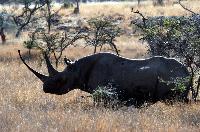 |
| Black Rhino |
|
Did you Know That?
1. Signs of the first humans have been found in several places in South Africa. The discovery of 117,000-year-old fossilized footprint, North of Cape Town prompted one researcher to speculate that "Eve" lived in South Africa.
2. Cape Town has 2 oceans, The Atlantic Ocean and the Indian Ocean.
3. In 1948, South Africa's National Party came to power on a platform of apartheid (literally, the state of being apart). The rights of many South African citizens were removed and people of each race were separated.
4. Today, South Africa's population is divided into roughly 3 racial classes; Blacks, Coloureds and Whites. There are 11 official languages. English is spoken throughout the country.
5. Nelson Mandela was elected to be president of South Africa in 1994 after being in prison for over 26 years.
6. The crimes of the apartheid era were exposed by the Truth & Reconciliation Commission (1994-1999). Nobel peace prize winner, Desmond Tutu said, "Without forgiveness there is no future, but without confession there can be no forgiveness". At this time in histoy, South Africa's final constitution was signed into law.
7. You can make a wonerful tea out of elephant dung. Just mix some old elephant dung andhot water. Very tasty.
8. In the bush you can make toothpaste out of leadwood trees and toothbrushes out of a stick from the majie quarry tree.
9. Elephants eat over 600 pounds of food a day.
10. The five most dangerous animals to hunt, often referred to as the big 5 are; Lion, Elephant, Rhino, Leopard and Buffalo.
11. Vultures fly very high and can see and cover tremendous territory. The highest recorded flying altitude of a vulture was 30,000 feet, spotted by a Boeing jet.
12. Safari in Swahili means to travel. Jumbo is Swahili for hello.
13. An Impala has four stomachs. As a survival technique, you can filter water out of the main stomach.
14. The back of an Impala has a marking similar to the McDonalds logo. They are often referred to as the big mac of the bush.
15. The Black Mamba is the most dangerous snake in Africa. It can kill a person within one hour. The Black mamba can sense vibration from 40 meters, travel 20km/hour with 1/3 of its body off the ground and will stalk its prey.
16. You may have referred to a grouping of lions as a pride. The collective name for other animals are: Dazzle of Zebras, Lip of Leopards, Journey of Giraffes, Crash of Rhino and a Pod of Hippos
17. When tracking an animal, always look for tracks early in the morning. This is often referred to as the morning news. It is easier to look at tracks into the sun and difficult to see tracks with the sun behind you.
18. There are very few Black Rhino's left in the world because of poaching and habitat encroachment (see photo on top of this page).
19. If you visit The Borana Ranch (see travel tips) you can visit the rock which inspired the Disney team, to create Pride Rock as an important symbol for "The Lion King"movie.
20. The Maasai girls have short hair and Maasai male warriors have long hair.
21. The Maasai's diet consists of milk, blood and meat.
22. Maasai people walk for many, many miles and don't drink water because they think it will slow them down.
23. Poaching of wildlife is a very serious problem. Poachers use snares (wire traps) to capture animals for the commercial meat trade. These snares are very dangerous to the animal population and injure many animals in bush. Several anti-poaching projects are sucessfully launched to stop poaching and rescue injured animals.
Click here on Alaska to read about what we learned on the first part of our trip.
|



